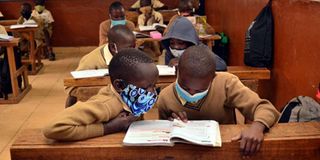Poorest pupils may never go back to school

Kevin Nziku (right) shares his Christian Religious Education textbook with his desk mate Samuel Kamau during a lesson on October 14, 2020 at Mathare North Primary School.
What you need to know:
- Education ministry needs to ensure that all children are not only enrolled, but also retained in school when they fully reopen.
- Many children could not access distance learning and, hence, did not learn during the school closure.
Getting children back into school after more than seven months of the Covid-19 pandemic-induced break is a critical national challenge.
Many children, especially the poorest and most marginalised, have been caught up in a vicious cycle of risk: As many were forced into child labour, adolescent girls faced violence like child marriage and early pregnancy.
As schools partially reopen, we are likely to see a sharp divide in attendance along wealth and gender lines with girls, refugees and children from poor families likely to be left behind.
Before the Covid-19 crisis, we already had high rates of education exclusion of over 850,000 children aged six to 17, according to the Ministry of Education.
Besides, many schools have failed to reopen, especially low-cost private institutions that were unable to remain a float and, as a result, closed.
Many of their students, mainly from informal settlements, are likely not to go back as some of the schools were converted to other businesses.
School fees
Further, parents who lost their sources of income due to the pandemic may not afford school fees and other related costs.
Education ministry needs to ensure that all children are not only enrolled, but also retained in school when they fully reopen. These include children with disabilities, refugees, internally displaced, girls and those from marginalised areas.
There is a need for awareness campaigns to ensure parents and communities get accurate and up-to-date information on reopening of schools and can communicate any fears they have concerning the health and wellbeing of their children.
Secondly, the government needs to enhance budgetary support to education to plug funding gaps to schools, which will need to procure additional school infrastructure, including desks, and increase learning and boarding spaces to meet government guidelines on social distancing and decongest classrooms and dormitories.
The photo that made the rounds in the media, of children seated on the classroom floor and a few others behind desks due to social distancing, should never recur.
Flexible learning environment
Thirdly, the ministry ought to devise a flexible learning environment. Many children could not access distance learning and, hence, did not learn during the school closure.
A Save the Children assessment in Mandera and Nairobi informal settlements revealed that nine in 10 children faced obstacles to learning at home. There is an urgent need to assess every child on return to school to identify learning gaps and appropriate remedial measures.
Finally, there is a need to gather the children’s views on school reopening to understand their feelings, anxieties and fears as they are primarily the most affected group and at the centre of any strategy, policy and decisions on education.
A third of the children in the assessment expressed their worry about their education, particularly around poor performance and forgetting what they had learnt.





